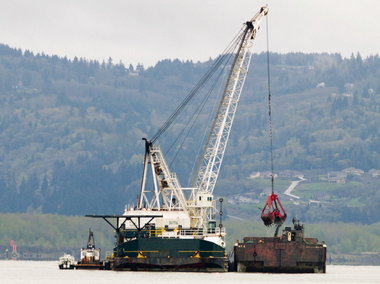forum
library
tutorial
contact

FERC Releases Draft EIS for Proposed Natural Gas
Terminal/Pipeline in Columbia River Estuary
by Staff
Columbia Basin Bulletin, August 7, 2015
|
the film forum library tutorial contact |

|
FERC Releases Draft EIS for Proposed Natural Gas
by Staff
|
 A coalition including fishing, public health, property rights, and conservation groups criticized a draft environmental review issued this week by the Federal Energy Regulatory Commission for the proposed liquefied natural gas terminal and pipeline in the Columbia River estuary.
A coalition including fishing, public health, property rights, and conservation groups criticized a draft environmental review issued this week by the Federal Energy Regulatory Commission for the proposed liquefied natural gas terminal and pipeline in the Columbia River estuary.
FERC staff prepared the draft EIS for the "Oregon LNG Terminal and Pipeline Project (Oregon LNG Project) and Washington Expansion Project."
LNG Development Company, LLC is requesting authorization to site, construct, and operate an onshore, import/export liquefied natural gas terminal and associated facilities on the East Bank Skipanon Peninsula in Warrenton, Oregon.
The proposed terminal includes feed gas pretreatment, liquefaction, and regasification facilities; two 160,000-cubic-meter LNG storage tanks; a turning basin; and berth for one LNG carrier.
The terminal would have a base load liquefaction capacity of 9.6 million tons per year and a base load regasification capacity of 0.5 billion cubic feet per day.
Oregon Pipeline Company, LLC is requesting a Certificate of Public Convenience and Necessity to construct and operate an 86.8-mile-long, 36 inch diameter bidirectional pipeline to transport natural gas to and from the terminal to interconnect with the interstate transmission system of Northwest Pipeline LLC, near Woodland, Washington; and construct a single electrically driven compressor station in Columbia County, Oregon.
FERC refers LNG Development Company, LLC and Oregon Pipeline Company, LLC collectively as Oregon LNG.
The groups opposing the project called on Oregon's Gov. Kate Brown to deny key state permits for the project "in light of FERC's failure to consider the best available science on LNG's impacts to public health and safety, endangered salmon, and the economy."
Cheryl Johnson, a Clatsop County resident and retired school librarian, stated, "Our community has spoken loud and clear in opposition to LNG. We are looking to Governor Brown to stand up for the best interests of Oregonians and deny state permits for this misguided project. FERC's rubberstamp approach to LNG development demands bold leadership to protect what we value: safe communities, strong salmon runs, and clean water."
In the draft environmental impact statement, FERC concludes that the project would cause adverse impacts to the environment, which the company can reduce through mitigation and engineering.
Clatsop County, Oregon has denied key permits for Oregon LNG's pipeline based on threats to public safety and local rivers.
Meanwhile, a federal judge ruled this week, in Oregon LNG's lawsuit against the U.S. Army Corps of Engineers, that the Corps has a valid legal right to use the proposed terminal property to deposit dredge spoils. Unless the Corps is willing to forfeit the right, Oregon LNG cannot build the proposed terminal.
"The Corps vigorously defended this lawsuit to protect a valuable public property right and the court got it right," stated Miles Johnson, Clean Water Attorney for Columbia Riverkeeper. "The court's ruling could spell the end to Oregon LNG's ten-year effort to site one of the most destructive, dangerous projects we've ever seen proposed on the Columbia River."
"Putting a massive LNG terminal in the heart of the lower Columbia's most popular commercial and recreational fishery undermines decades of work to protect fishing opportunities in the lower Columbia River," said Dan Marvin, a longtime Columbia River commercial fisherman. "On top of this, our region has invested billions of dollars in restoring salmon habitat. FERC has its head in the sand when it concludes this project won't have a significant impact on our livelihoods."
Oregon LNG's dredging alone would destroy critical habitat for twelve stocks of endangered and threatened salmon and steelhead, contend the opponents.
Regarding impacts on species listed under the Endangered Species Act, the draft EIS says consultations with U.S. Fish and Wildlife Service and National Marine Fisheries Service are in progress.
"Many of these species have designated critical habitat (habitats that are considered to be essential for the recovery of the species) that are crossed by the project and one species has proposed critical habitat. We are in the process of completing our Biological Assessment, our consultation with FWS and National Marine Fisheries Service (NMFS) is in progress, and our final determination regarding the effects on species is pending. Therefore, we are recommending that no ground disturbance occur until we have completed our Section 7 Endangered Species Act consultation with the FWS and NMFS before Oregon LNG and Northwest proceed with construction."
Comments on the draft EIS must be received in Washington, DC on or before October 6, 2015. Once the final EIS is issued, the FERC Commissioners will take into consideration staff's recommendations when the Commission makes a decision on the projects.
Related Pages:
Oregon Land Use Board Denies Columbia River Estuary Liquefied Natural Gas Pipeline Appeal by Staff, Columbia Basin Bulletin, 5/1/15
Comments On Proposed LNG Terminal In Columbia River Estuary Suggest Harm To Salmon Habitat by Staff, Columbia Basin Bulletin, 2/13/15
learn more on topics covered in the film
see the video
read the script
learn the songs
discussion forum
